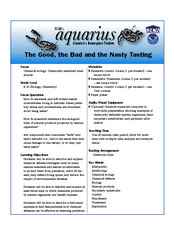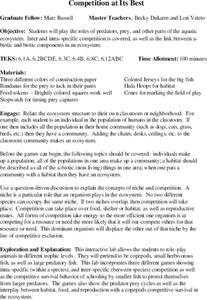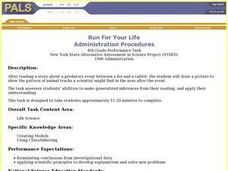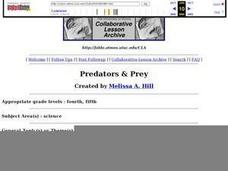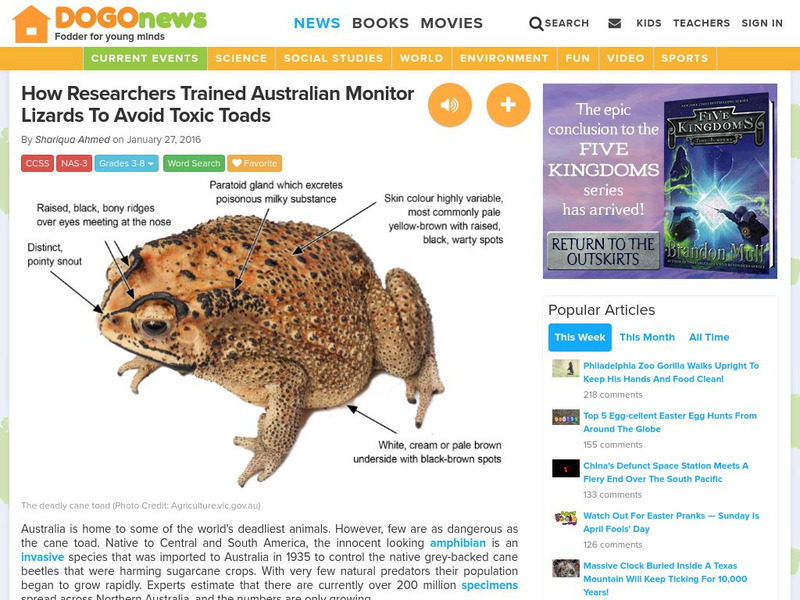Curated OER
Laws of the Jungle
Students build a video game on predator-prey relationship. In this biology lesson, students identify the variables that affect this relationship. They write a short description and play each other's game.
Curated OER
The Good, the Bad and the Nasty Tasting
Students examine the effect of chemicals from marine plants or animals on predator's preferences. In this ecology lesson, students conduct taste tests and collect necessary data. They write their conclusion after analyzing experimental...
Curated OER
Mariposas
Students examine how animals use camouflage for survival. In this investigative lesson students define vocabulary words and see how it is the environment that controls which adaptations will help in survival.
Curated OER
Amusing Animal Adaptations
Students identify how animals adapt characteristics to help them survive or reproduce. In this animal lesson, students draw pictures of their animal and adaptation.
Curated OER
GED Vocabulary: Life Science
In this life science worksheet, students review terms such as genetics, mutation, trait, predator, and herbivore by completing 8 questions in this crossword puzzle.
Curated OER
Micro-organisms and Ecology
In this ecology worksheet, students identify and locate various vocabulary terms pertaining to micro-organisms and the study of ecology. There are 30 biology terms located in the word search.
Curated OER
EcoFluxx
Students describe examples of predator/prey relationships in nature explain how some animals protect themselves from predation better follow all directions presented to them become more flexible, adaptable and literate learners. They...
Curated OER
Butterfly Camouflage
Fifth graders discuss camouflage and warnings by butterflies as a class. Students design and color their own butterflies that they are to place somewhere in the classroom. Students explain why their butterfly is colored the way that it...
Curated OER
Dull Duck, Dashing Duck
Students examine the different colors and patterns found on animals bodies, specifically birds. Through discussion, students discover the use of the colors and patterns for protection from predators and the advantages while hunting prey,...
Curated OER
Compettion at its Best
Sixth graders role play predators, prey and other parts of the aquatic ecosystem. They show inter and intra-specific competition as well as the link between abiotic and biotic components in an ecosystem. Students play games about the...
Curated OER
CSI Clamshell Investigation
Students explore predator/prey relationships. They research information on moon snails and claims. Students draw conclusions from the data collected. They use math and graphing to determine if there is a relationship to the clam's size...
Curated OER
Mimics Survive -- Camouflaged Reptiles
Students examine mimicry as a survival strategy in repiles. They examine examples of the Mexican milksnake and the coralsnake in attempt to distinguish the differences in them. They discuss other species that use mimicry.
Curated OER
Run For Your Life
Students draw a picture of animal tracks a scientist might find after they read a story about a fox chasing a rabbit. They make up a key to represent the foxes' tracks and the rabbit's tracks.
Curated OER
Predator Prey Population Links
Fifth graders relate population of animals to its available food supply. They participate in an experiment and gather information. They use the data to draw conclusions.
Curated OER
The Big Bad Wolf
Tenth graders analyze the popular fairy tale "The Three Little Pigs" for inaccurate references to wolves. They write a story (or compose a song) that correctly depicts the characteristics, traits and predator-prey relationship of a wolf.
Curated OER
Predators & Prey
Students discuss what predators and prey are. Students participate in a playground game aimed at simulating predators and prey.
Curated OER
A Tale of Two Cranes How Do Wild and Costume-raised Whoopers Compare?
Students explore what young cranes need to do to survive.
Sheppard Software
Sheppard Software: Animal Profiles: Wolves
In addition to information about different kinds of wolves, this site gives extensive information about wolf behavior. Find out the many different ways wolves communicate with each other.
PBS
Pbs Nova: Crocodiles!
This PBS Nova site lists a table of contents on subjects involving the Crocodile. How did they outlive the dinosaurs? What makes them tick? What are the different types of crocodiles?
Other
Pde Sas: Relationships Among Organisms
In this lesson, young scholars compare various types of relationships among organisms (i.e., biotic interactions). Students will: explain the roles of producers and consumers, and predators and prey in an ecosystem. Explain the levels of...
DOGO Media
Dogo News: Scrunchies May Save Birds From Fiercest Predator
Read about a wearable device that may help prevent birds from being attacked and killed by cats. Includes video.
DOGO Media
Dogo News: How Researchers Trained Lizards to Avoid Toxic Toads
Learn about the toxic Australian cane frog. Includes video.
San Diego Zoo Global
San Diego Zoo: Jaguar
This resource provides detailed information about the jaguar. It also provides several photos and a video. [0:48]
African Wildlife Foundation
African Wildlife Foundation: Cheetah
The African Wildlife Foundation provides a detailed overview of the cheetah. Here you can learn about a cheetah's physical characteristics, behavior, diet, caring for young, predators, and more.



